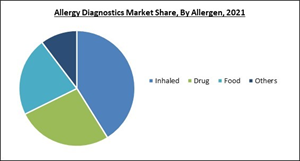Outlook on the Allergy Diagnostics Global Market to 2028: Increasing Levels of Environmental Pollution and Using Mobile Health to Diagnose Allergies Drives Growth

allergy-diagnostics-market-share.jpg

Dublin, March 02, 2023 (GLOBE NEWSWIRE) -- The "Global Allergy Diagnostics Market Size, Share & Industry Trends Analysis Report by End-user, Allergen, Test Type, Product & Services, Regional Outlook and Forecast, 2022-2028" report has been added to ResearchAndMarkets.com's offering.
The Global Allergy Diagnostics Market size is expected to reach $11.4 billion by 2028, rising at a market growth of 13.3% CAGR during the forecast period.
Key Market Players
Danaher Corporation
Hitachi chemical Diagnostic Inc.
Hycor Biomedical Inc.
Lincoln Diagnostics Inc.
Omega Diagnostic Llc
Siemens Healthcare Diagnostics, Inc.
Thermo Fisher Scientific Inc.
Neogen Corporation
Eurofins Scientific Group
ACON Laboratories, Inc.
Techniques for diagnosing allergies include skin prick tests, patch tests, intradermal tests, and blood tests. As pollution levels rise, the market for allergy diagnostics is anticipated to expand. The main risk factors for chronic respiratory illnesses include occupational exposure, exposure to allergens, and exposure to both indoor and outdoor air pollution.
Due to their greater exposure to environmental pollutants, urban individuals are more susceptible than rural ones to suffering allergy disorders. The market for allergy diagnostics is expected to grow due to the increase in food allergies. The allergy cases are more common in urban areas instead of rural areas. The degree of cleanliness and potential for infectious diseases is one of the most noticeable differences between these places.
Early exposure to viral, bacterial, and parasite infections as well as exposure to a number of common human body micro-organisms are predicted to have an impact on immune system development. Climate change, air pollution, as well as the complexity of materials and cosmetic products have all contributed to a rise in the prevalence of sensitive skin and its susceptibility to irritation. These elements are anticipated to fuel the market for allergy diagnostics in the near future.
COVID-19 Impact Analysis
Due to the COVID-19 outbreak, there was a little reduction in the market for allergy diagnostic. Given that suffering patients are well-instructed about avoiding probable environmental triggers and treating acute occurrences, also based on written action plans, diagnostic tests were postponed in the majority of allergic disorders.
However, after the pandemic was under control, the diagnostic processes were restarted. To determine the impact of COVID-19 on allergy diagnostic testing services, several researches have been done.
Market Growth Factors
Increasing levels of environmental pollution
The main risk factors for developing chronic respiratory disorders include occupational exposure, allergen exposure, and exposure to indoor and outdoor air pollution.
Due to the greater exposure to environmental toxins in cities, the prevalence of allergy illnesses is higher among urban residents than rural residents (as a result of vehicular pollution and industrial activities). Although this is a worldwide phenomenon, its impacts are more severe in the metropolitan regions of low-income nations, where more than 80% of people live in locations where air quality levels exceed WHO safety guidelines.
Using mobile health to diagnose allergies
There are currently just a few mHealth tools for diagnosing allergic rhinitis (AR) that have been published in peer-reviewed publications, which limits the use of mHealth for the diagnosis of rhinitis. A new breed of point-of-care devices is produced by recent advancements in wireless communication, integrated biosensors, and power harvesting techniques. However, AR is a very widespread illness all over the world. Peak nasal inspiratory flow meters and intranasal biosensors are only two examples of diagnostic tools that can be connected to smartphones.
Market Restraining Factors
Instruments for diagnosing allergies come at a premium price
Market competitors regularly update a number of allergy diagnostic tools, including luminometers, scanners, blot analyzers, ELISA analyzers, and immunoassay analyzers. These instruments cost more because they come with cutting-edge features and functions (the cost of each instrument varies on the basis of its flexibility, accuracy, and TAT). Due to their substantial capital expenditures and ability to purchase high-volume systems, large hospitals and diagnostic laboratories hold a higher portion of the market.
Scope of the Study
Market Segments Covered in the Report:
By End-user
Diagnostic Laboratories
Academic Research Institutes
Hospital-based Laboratories
Others
By Allergen
Inhaled
Drug
Food
Others
By Test Type
In Vivo
In Vitro
By Product & Services
Consumables
Instruments
Services
By Geography
North America
US
Canada
Mexico
Rest of North America
Europe
Germany
UK
France
Russia
Spain
Italy
Rest of Europe
Asia Pacific
China
Japan
India
South Korea
Singapore
Malaysia
Rest of Asia Pacific
LAMEA
Brazil
Argentina
UAE
Saudi Arabia
South Africa
Nigeria
Rest of LAMEA
For more information about this report visit https://www.researchandmarkets.com/r/e7t7y5
About ResearchAndMarkets.com
ResearchAndMarkets.com is the world's leading source for international market research reports and market data. We provide you with the latest data on international and regional markets, key industries, the top companies, new products and the latest trends.
Attachment
CONTACT: CONTACT: ResearchAndMarkets.com Laura Wood,Senior Press Manager press@researchandmarkets.com For E.S.T Office Hours Call 1-917-300-0470 For U.S./ CAN Toll Free Call 1-800-526-8630 For GMT Office Hours Call +353-1-416-8900


 Yahoo Finance
Yahoo Finance 
